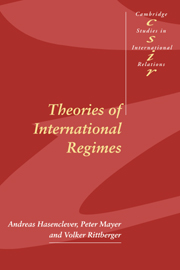Book contents
- Frontmatter
- Contents
- List of figures and tables
- Acknowledgments
- 1 Introduction: three perspectives on international regimes
- 2 Conceptual issues: defining international regimes
- 3 Interest-based theories: political market failure, situation and problem structures, and institutional bargaining
- 4 Power-based theories: hegemony, distributional conflict, and relative gains
- 5 Knowledge-based theories: ideas, arguments, and social identities
- 6 Conclusion: prospects for synthesis
- References
- Index
- CAMBRIDGE STUDIES IN INTERNATIONAL RELATIONS
1 - Introduction: three perspectives on international regimes
Published online by Cambridge University Press: 05 September 2009
- Frontmatter
- Contents
- List of figures and tables
- Acknowledgments
- 1 Introduction: three perspectives on international regimes
- 2 Conceptual issues: defining international regimes
- 3 Interest-based theories: political market failure, situation and problem structures, and institutional bargaining
- 4 Power-based theories: hegemony, distributional conflict, and relative gains
- 5 Knowledge-based theories: ideas, arguments, and social identities
- 6 Conclusion: prospects for synthesis
- References
- Index
- CAMBRIDGE STUDIES IN INTERNATIONAL RELATIONS
Summary
More than twenty years after students of international relations began to ask questions about “international regimes” (Ruggie 1975), scholarly interest in the “principles, norms, rules, and decision-making procedures” (Krasner 1983c: 2) that govern state behavior in specific issue-areas of international relations continues to be strong. It may be the case that the term “regime” has lost some of its earlier charm (Milner 1993: 494). But the substantive questions that define the regime-analytical research agenda — whether couched in terms of “regimes,” “institutions” or otherwise — still count among the major foci of International Relations scholarship in both Europe and North America. What accounts for the emergence of instances of rule-based cooperation in the international system? How do international institutions (such as regimes) affect the behavior of state and non-state actors in the issue-areas for which they have been created? Which factors, be they located within or without the institution, determine the success and the stability of international regimes? Is it possible to come up with non-idiosyncratic explanations for the properties of particular institutional arrangements (such as the extent to which they are formalized)?
Various theories have been proposed to shed light on at least some of these questions. According to the explanatory variables that these theories emphasize, they may be classified as power-based, interest-based, and knowledge-based approaches, respectively.
- Type
- Chapter
- Information
- Theories of International Regimes , pp. 1 - 7Publisher: Cambridge University PressPrint publication year: 1997



